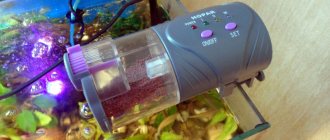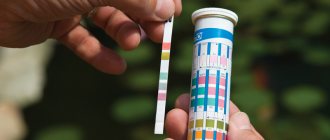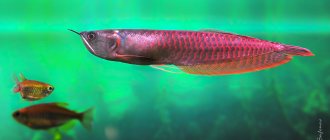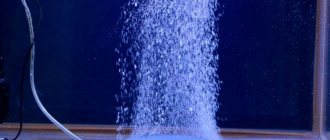How to make a net
Hello to all readers of my blog! Every aquarist can make a net for an aquarium. Perhaps someone will say that it’s easier to buy and they will be partly right, why bother with a needle, thread and wire when you can just buy, especially since it doesn’t cost much money.
In fact, how much easier and more convenient it will be for you when working with catching fish depends on the net, or rather, on its size. The idea for using a large net (a hoop with a diameter of 20 cm) did not come to me right away.
The large net that I now use for fish was originally made for catching coretras and daphnia, but the daily torment of catching fish for buyers gave me the idea to use a large net, because catching fish with an ordinary net takes a lot of time and patience.
If you don’t catch fish often and don’t go looking for bark and daphnia, you may not need a large net, but it still won’t hurt to make a spare net. Once at a pet store I was buying zebrafish and I felt sorry for the seller who took about 15 minutes to catch 4 fish. At this time I was thinking how I was missing a big net right now.
Basic food for a chameleon
The main and favorite food of chameleons are various non-poisonous, flying and crawling insects and their larvae:
- beetles;
- spiders;
- flies;
- butterflies;
- dragonflies;
- grasshoppers;
- locusts;
- other insects.
Did you know? Chameleons have an innate protective instinct against eating poisonous insects such as a bee or wasp.
In addition to insects, many species of this reptile do not disdain to hunt small animals:
- lizards;
- rodents;
- small birds.
Chameleons also eat plant foods.
How to make a net with your own hands
To make a large net you will need: a piece of rigid wire approximately 120 cm, preferably (not necessarily) made of stainless steel with a diameter of 4-5 mm. Not very dense fabric organza, chiffon, nylon, nylon, voile No. 7-76.
The shape of the hoop, square or round, doesn’t matter, I make it square with each side measuring 20 cm, and twist the remaining tails of the wires, they will serve as a handle. If the handle seems short, you can lengthen it.
Next we make the pattern and the bag. Bags for nets can be different, for example, simply from two halves of fabric, the pattern of which has a parabolic shape. Or a cross-shaped pattern, which is considered the most profitable of all possible options. The bag turns out to be rectangular with a flat bottom and safe for fish when catching them.
Honestly, I used different nets and didn’t hurt a single fish, and it seems to me that this depends on the aquarist himself, and not on the shape of the bag. We carefully measure the pattern, taking into account the fact that the length of the bag should be about half the diameter of the hoop (in my case 30 cm), we also take into account the part of the wrapped material on the lining of the darling.
To improve the quality of the net, it is advisable to strengthen the areas where the shell is sheathed by sheathing it with additional material. To catch daphnia or coretra, we attach the net to a pole by wrapping the handle of the net with wire or rope.
Source
Appearance
The following can be said about the structure of cockerels:
- body shape is oval, it is elongated and slightly flattened laterally;
- the fish itself is small, reaches 5-6 cm in length, females are even smaller;
- the pectoral fins have a pointed shape, the caudal and dorsal fins are rounded;
- The natural color is dark brown, with spots, but as a result of breeding work, other species were obtained.
@ivabalk pixabay.com
Breeders have done a great job, and today there are more than 70 breeds of cockerel. They are all different, differing not only in body color, but also in the shape of their fins.
Universal net for aquarium
V. Miloslavsky. Aquarium No. 2, 1994
Let's say you want to catch an ancistrus lurking at the bottom in an aquarium 50 centimeters high. Naturally, you will need a net with a handle 60-70 centimeters long. But if, with the same net, you try to catch an epiplatis standing at the very surface of the water, then the long handle will only be a hindrance.
Another situation. Try to catch nimble barbs in the free space of the aquarium with a small net - you are unlikely to succeed, you need a large net. At the same time, using such a net to catch graceful lalius in the dense thickets of an underwater garden will almost inevitably lead to damage to the plants.
Thus, for convenience, it is advisable for the aquarist to have at his disposal several nets of different sizes with handles of different lengths. But, in my opinion, it is much more convenient to use one net with a sliding handle and interchangeable frames, which you can make yourself.
A telescopic antenna from an old receiver or small-sized TV is quite suitable for the handle (they are usually made of stainless steel or chrome-plated and therefore are not subject to corrosion). Their alteration is minimal. You just need to remove several of the upper, thinnest sections (their number depends on the maximum length of the handle of your net) and grind a handle from wood or plastic with a hole drilled inside into which the lower section will be placed using epoxy glue.
It is even better for this purpose to use a ballpoint pen sold in office supply stores, from which the writing rod holder has been removed. When folded, this handle has a length of 12 centimeters, the maximum length is 52.
To make replaceable frames, stainless steel wire (or other metal that does not interact with water) with a diameter of 3 millimeters is used, which corresponds to the internal diameter of the upper section of the pointer handle. If a telescopic antenna is used, then the diameter of the wire must be selected so that the frame pin fits tightly enough into the hole in the upper section of the antenna and ensures reliable fixation of the net frame. If the diameter of the wire is less than desired, then a small “wave” is made at the nozzle section due to a slight bend of the wire in this place. This ensures a completely satisfactory clamping of the frame pin in the handle of the net.
Compatibility with other fish
Of course, cockerels are cocky, so choosing neighbors for them is not easy. There are several compatibility groups:
- High compatibility: poeciliaceae, corydoras, ancistrus, iris, rasboras.
- Average livability: angelfish, barbs, neons.
- Lack of compatibility: goldfish (veiltails), large cichlids, predators.
When introducing a betta into a community aquarium, you must carefully observe its behavior. If other fish try to injure or bite it, it is better to isolate the betta. It is also worth doing if an individual encroaches on other fish.
@JuanCarlosPalauDiaz pixabay.com
The fish with bright colors and long, veil-like fins are the first to suffer from attacks by bettas. Sometimes it may seem that the betta has a complex and wants to destroy the individual in order to be the most beautiful resident of the aquarium.
If for some reason a betta is not right for you, find out about other fish that can decorate any aquarium.
AquaDomik.ru
Let's say you want to catch an ancistrus lurking at the bottom in an aquarium 50 centimeters high. Naturally, you will need a net with a handle 60-70 centimeters long. But if, with the same net, you try to catch an epiplatis standing at the very surface of the water, then the long handle will only be a hindrance.
Another situation. Try to catch nimble barbs in the free space of the aquarium with a small net - you are unlikely to succeed, you need a large net. At the same time, using such a net to catch graceful lalius in the dense thickets of an underwater garden will almost inevitably lead to damage to the plants.
Thus, for convenience, it is advisable for the aquarist to have at his disposal several nets of different sizes with handles of different lengths. But, in my opinion, it is much more convenient to use one net with a sliding handle and interchangeable frames, which you can make yourself.
A telescopic antenna from an old receiver or small-sized TV is quite suitable for the handle (they are usually made of stainless steel or chrome-plated and therefore are not subject to corrosion). Their alteration is minimal. You just need to remove several of the upper, thinnest sections (their number depends on the maximum length of the handle of your net) and grind a handle from wood or plastic with a hole drilled inside into which the lower section will be placed using epoxy glue.
It is even better for this purpose to use a ballpoint pen sold in office supply stores, from which the writing rod holder has been removed. When folded, this handle has a length of 12 centimeters, the maximum length is 52.
To make replaceable frames, stainless steel wire (or other metal that does not interact with water) with a diameter of 3 millimeters is used, which corresponds to the internal diameter of the upper section of the pointer handle. If a telescopic antenna is used, then the diameter of the wire must be selected so that the frame pin fits tightly enough into the hole in the upper section of the antenna and ensures reliable fixation of the net frame. If the diameter of the wire is less than desired, then a small “wave” is made at the nozzle section due to a slight bend of the wire in this place. This ensures a completely satisfactory clamping of the frame pin in the handle of the net.
It is best to have in one set two or three ordinary flat rectangular-shaped frames (Fig. 1), each of which is 1.5-1.6 times larger diagonally than the previous one. The specific dimensions of the frames must be selected in accordance with the volume of the aquarium and the size of the fish contained in it.
DIY aquarium net.
Yes, I never intended to make an aquarium net . It would seem like something, but there is enough of this goodness in stores. But no, my Brown Paku grew up to about forty centimeters. And it no longer fits into any standard net. And it needs to be replanted from time to time. Although such a need does not arise often, the question of how to transplant it normally torments each time. The fish is large and strong and has an absolute aversion to any kind of transplantation. Apparently he thinks that I’m up to something bad every time and hides a large frying pan with heated oil behind my back.
It was for this simple reason that the first homemade aquarium net was born. Actually, for its production, the wire that came to hand was seized. After turning it over in my hands and thinking about all sorts of options, it was decided to make a simple rectangular profile and not bother. Using pliers, a rectangle was bent. Moreover, you need to start with about two-thirds of the length of the wire. After bending the rectangle, we bend the handle of our net from the middle at a right angle. It was decided not to make the handle too long.
It was inserted into a plastic casing and then wrapped with electrical tape. The net also came in very handy. It was a piece of synthetic mosquito net with a mesh diameter of about a millimeter. Such a net is usually stretched over windows in the summer to protect against midges and mosquitoes. In order to determine the size of the mesh, I measured the perimeter of the wire rectangle and, based on this, cut out a rectangular piece of the mesh with an allowance of about 2 cm for stitching. I sewed the net by hand using nylon thread. For the first time it turned out okay, but of course not a machine seam. The main thing is that my large net began to perform its functions properly, and now there was no danger of dropping the fish on the floor. Subsequently, it turned out that a large net is good not only for large fish, but also for schooling, but not very large fish (neons, tetras, barbs and the like are caught by a whole school).
I also made other aquarium nets as needed. For example, a commercial net refused to fit into an ordinary glass jar. And the need to get a fish out of a jar arises periodically. I had to spend my free time making a small net for this purpose.
Now let’s take a closer look at how to make it – this unusual ordinary net.
The first thing, of course, is to make a wire frame. The wire must be selected depending on the dimensions, thickness and stiffness. For large nets, steel wire with a diameter of 2–5 mm is suitable. The larger the hoop of the net, the larger the diameter of the wire. To bend it you need pliers. If the frame is rectangular, you need to make sure that all the corners are right. A round hoop can be made by bending a wire around a suitable object (cans, mugs, bucket).
Aquarium fish net
It has different purposes and performs different functions.
The first is a net for feeding fish. Usually it is small in size (length * width), or diameter, about 5 cm. It is equipped with a strong handle made of the same material from which the net itself is made, or handles made of a different material, but firmly connected to the net, for example, with threads (glue). The net is equipped with a net into which food is poured and fed to the fish. As a rule, this is live food; in fact, it replaces the functions of a cone feeder. For more information about such a feeder, you can see the information in the article “Feeders for aquarium fish” Second. The net is used to catch food for fish. Such a net, as a rule, is of a larger size - diameter 25-30 cm, length of the bag up to 40 cm. With its help, various small food is caught in stagnant lakes and ponds. Third. A net for catching fish. Sometimes aquarists need to transplant fish to other aquariums, for example, to completely clean the aquarium. Such a net should be at least 12x12 cm in size so that it can catch both small and large fish. The length of the handle should be such that you can reach any corner of the aquarium and catch a naughty fish. But, since even a short stay in the air can have a detrimental effect on the health of the fish, glass nets are used to catch and transplant them. In this case, contact with air is excluded. Of course, you can make nets with your own hands, there are no problems here. Anyone who has ever seen a net will understand that this is not a problem. The wire is made of stainless steel or copper, it is much softer and easier to bend, with a diameter of 3-5 mm. Bends to your size
depending on what kind of net you want to make. As we said, there are nets: - for food; - catching fish food; - for catching the fish themselves.
The handle can be left made of wire, or a handle can be attached, which would increase the rigidity of the handle. For the handle, you can use a telescopic pointer, so you will have a handle with variable length. Then the bag of the net is sewn together.
(when cutting the net, the following proportions must be observed: 2g = 2A + 2B)
The material used is lavsan or nylon fabrics with a mesh size of 1-1.5 mm. Then the fabric is sewn with fishing line or nylon thread 0.1-0.12 mm, and the same fishing line (thread) is used to sew the net to the metal base.
Discus breeding
To breed discus fish, you need to find a good pair. It is not difficult to obtain offspring from a formed pair.
problems often arise :
- The formed pair does not begin preparing the substrate for spawning.
- One of the partners is aggressive.
- The formed pair laid eggs on the selected substrate, and then both parents lost interest in the clutch.
- The formed pair lays eggs on the selected substrate, and then one of the partners begins to behave aggressively towards the other.
- The formed pair lays eggs on the selected substrate, and then during the courtship process, one of the parents eats the eggs. This problem often occurs due to the presence of other fish in the aquarium.
In order for spawning to begin, the water temperature must be 30-32 degrees. At lower temperatures, producers abandon the clutch and the eggs do not hatch. The water in the spawning tank should be slightly acidic and soft. In hard water, the fertility of eggs is significantly reduced.
Photo: mom lays eggs on the wall of the aquarium
Laying eggs close up
An aquarium with a volume of 100 liters without plants and soil is suitable as a spawning tank. The female can lay eggs on a ceramic pot, driftwood, a special cone, and even on the surface of the internal filter. Water changes are carried out as in a general aquarium. The female lays from 200 to 400 eggs. The male fertilizes the eggs. After two days the eggs hatch. All this time, the parents guard the clutch.
During the first two weeks, the hatched fry feed on skin secretions secreted by their parents. If one of the parents has little mucus, then it may begin to eat the offspring. To protect the offspring, breeders stretch a mesh with cells between the parents. In this case, the fry swim freely from one parent to another. As the babies mature, they are fed Artemia nauplii, and as they grow, they are switched to food for adult discus fish. The babies are fed little by little, but often.
The spawning area must be kept clean. To do this, it is necessary to remove the remains of uneaten food after each feeding.











